
|
|
Flip Flappers
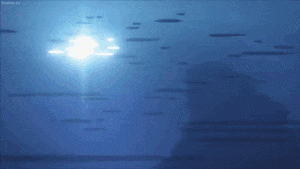 Trust me, I know, life is scary. But just put those colors on, girl. Come and play along with me tonight. Imagination is one of the most amazing abilities human beings possess. It's a power that defies explanation. A force without form, an incomprehensible enigma of infinite potential that we can use to envision possibilities, forecast futures, process emotions, and even escape from our everyday lives. What's more, it's something every single human on the planet has access to, innately. This power to create entire worlds inside our minds, with unlimited use and complete artistic license, and nothing we or anyone else can create in our world will ever compare to its incalculable power. No wonder it's such a fascinating concept to center a whole story around!
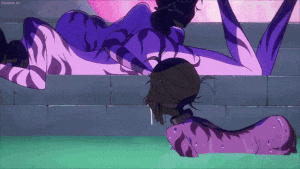 Even with no limits to speak of, it's astonishing how often people use imagination to simply dream up new types of sexy villain women. So, let's talk about Flip Flappers. It's a short, 13-episode anime original that takes the common conundrum of a young girl unsure of her identity and place in the world, and turns it into a grand production full of wacky misadventures and internal conflict and strikingly beautiful artwork. Tapping deep into the wellspring of unbridled fantasy, the show uses the power of escapism and genre parody to offer a deceptively complex story about a very simple feeling that most of us encounter at some point or other in our lives. And unlike some other genre parody shows of its era, this one disavows the need to be smug or intellectual about it, preferring instead to simply embrace the inexplicable magic and power of imagination, and to let that do the talking. Our main character (Cocona) is an emotionally distant and somewhat rigid teenager who is presently facing the looming threat of becoming what society perceives as "an adult", and hasn't yet decided on a career or taken up an identity for herself. Lost in her own head, Cocona's entire world is thrown into chaos by the sudden appearance of an eccentric and vivacious girl about her age (Papika) who all but crashes into her from atop her flying surfboard and, after some additional shenanigans, invites her on an adventure. Warily, Cocona ends up tagging along before her brain has a chance to catch up to the situation and reject her. Thus, accompanied by an oddly pervy robot with a squishy organic brain for a CPU, the two of them fall down a rabbit hole into a bizarro otherworld one step outside of reality, a world they'll later come to know as "Pure Illusion".
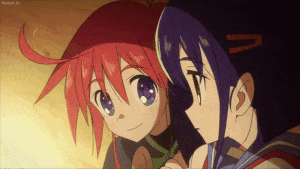 Curiosity may have gotten it killed, but the cat came back the very next day... Each episode of the show takes Cocona and Papika in and out of some new miniature fantasy-scape with its own independent world and story, all in search of magical crystal shards (Amorphous) that - once gathered - will supposedly grant the collector's deepest wish. Although the locales are rooted in familiar storytelling tropes, every instance of Pure Illusion feels distinctly unique. Whether it's an episode about living together on a deserted island, rescuing cute little critters from desert bandits, or escaping a time loop in a creepy school full of faceless children, Flip Flappers molds itself in the realm of imagination. And yet despite all that glitz and glamour, the core of the story remains rooted around Cocona learning to overcome her crisis of identity through her relationship with Papika. (If that also sounds like a potential queer awakening story to you, congratulations! You've definitely noticed there's an ongoing pattern with the type of shows I like to review!) With only a meager 13 episodes to work with, none of these cool fantasy worlds stick around for more than a single episode. Like a child's imagination, the series moves at a breakneck pace, and while there are certainly moments of calm here and there, there's no room for getting too cozy. There's an almost conspiratorial second narrative to the whole story as well, hinting at the "true nature" of the Amorphous they're seeking, Papika being a member of a secret scientific organization, and Cocona's childhood friend Yayaka competing against her to recover the shards for her own cryptic purposes that she won't reveal. But regardless of the drama and intrigue of the plot or the voluminous depth of the lore, the center spotlight stays fixated on Cocona's coming of age story.
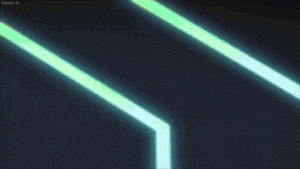 Where some might argue that a show spreading itself this thin equates to bad writing, I just see a show worth rewatching multiple times to pick up on all its nuances. Before I dive further into all that, I want to talk briefly about the show's excellent art direction. In the "real" world, brilliant saturated colors against soft watercolor backgrounds give the whole thing a lively children's storybook feel, with dashes of pencil shading providing undertones of something deeper lurking underneath. But these backgrounds are also rife with little touches of unreality strewn about everywhere - from odd curvatures in the architecture to unusual oversized plant life to grandma's high tech wooden rocker wheelchair - that add a subtle sense of curiosity and surreality before we've even left the school grounds. The music adds a lot as well, often making use of plucked strings and meandering piano phrases during the more whimsical moments and genre-appropriate rock and electronica for the inevitable fight scenes (oh, were you worried this show was going to be normal?). The wacky Pure Illusion worlds turn all of this up to 11. Sometimes set in natural biomes like snowy mountains and clover fields, other times set in a harshly colored no man's land that resembles an avant-garde painting, the backgrounds in Pure Illusion are often sprawling and bursting with intricate detail. It's easy to get distracted in a show like this, and that's perhaps all part of the show's master plan to spring its story surprises on you while you're not paying attention. It's a show packed with complexity, and it's goddamn gorgeous from end to end.
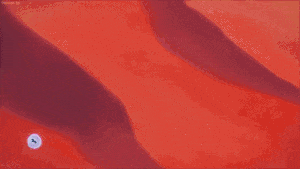 Most episodes also feature a wildly kinetic action scene or two that give any bog standard shounen series a run for its money. As Cocona and Papika travel from world to world in search of the Amorphous, the nature of these unpredictable Pure Illusion worlds slowly starts to come into focus. Each one represents a different sort of mental roadblock that Cocona has been dealing with in the Real World during her quest for purpose and meaning. Learning to take that step into the unknown, trusting someone else to be there for her, experimenting with romance...all shortcomings that are explored through these fantastic flights of fancy. Each imaginary world has its own story that Cocona and Papika become players in - sometimes as companions, sometimes as adversaries - and all of it works in service of Cocona's growth as a person. And Papika is instrumental in her learning these life lessons, as she represents the sort of unchained, natural zeal for life that's been missing from Cocona's world. It isn't so much that Cocona was a stick in the mud who needed to loosen up, but more like she had been living her life in a haze, paralyzed by indecision and fearing failure, as if choosing an identity were some kind of test that has a "correct" answer. This is depicted multiple times in a dream sequence, usually at the beginning of an episode, where Cocona finds herself drifting upon a boat down a foggy river, alongside an eerie doppelganger of herself. Adventuring with Papika provides exactly the kick in the pants she needs to stop worrying about the unknown and start truly living as her own self.
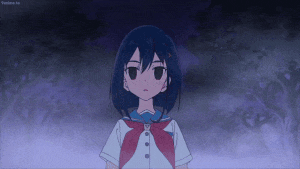 It's hard not to compare this visual to going down the river Styx, with Cocona surrendering herself to the whims of the ferryman as she rides between two possible worlds. But equally instrumental is cold, logical realist Yayaka. Although she's playing the part of the rival, collecting Amorphous for herself alongside two creepily monotone white-haired kids (you know the type), she's still a close childhood friend from the Real World, and it's clear that Cocona wants to keep it that way. Despite constantly pressuring her to give up on collecting shards and to stop playing ridiculous games with immature wild child Papika, her friendship means a lot, and ironically it's Yayaka's interference in their adventures that completes the circuit and sparks Cocona to start standing up for herself, as herself. In a loose way, the three of them comprise a sort of id-ego-superego relationship, with Cocona being the ego of the group. Papika and Yayaka represent two extremes whose influences on Cocona work in tandem to pull her out of that mental fog, to help her rediscover a balance between the two that works for who she wants to be. It's not a direct 1:1 parallel, since Papika and Yayaka are also their own people acting on their own agency, but it's a neat allusion that helped me process this show as a coming of age story. Perhaps most importantly though, all of this rides on their adventures together in Pure Illusion, an imaginary world shaped by and actively mirroring Cocona's own subconscious perceptions of herself and her relationships to these two chuckleheads.
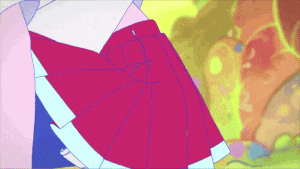 Elsewhere in Pure Illusion, a furry is born. And there was much rejoicing. As I mentioned, there is a second layer to the story, a sort of sci-fi endeavor that paints Pure Illusion as some kind of parallel universe being studied by a secret government organization (the eponymous FlipFlap), using Cocona and Papika as test subjects to gather the Amorphous for some arcane purpose. It's the sort of "intellectual" breakdown that attempts to explain traditional magical girl tropes in a very logical and literal kind of way that, while intriguing, kind of threatens to break the entire premise of the show. By chalking up the use of escapism and imagination as some kind of paramilitary science experiment centered around tapping into Cocona's "ability" to manifest these worlds, it risks overtaking the story of self-discovery that the rest of the show hinges on. Trying to apply this sort of realistic, adult filter as the show's "true" story distracts from the essence of these fantasy worlds and what their resolutions represent. Our imaginations are a playground we use to exercise our own creativity, to help process our emotions or derive new meanings from our memories and experiences, not some kind of alternate reality that can be tapped for unlimited power (nice try, Dimension W). I'm not saying this deconstructive sci-fi angle isn't entertaining or fun to speculate on, I just think it works EVEN BETTER when you treat it like it's all simply another layer of Pure Illusion.
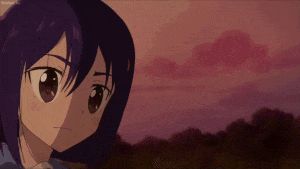 This isn't quite what I meant when I called the story "captivating". It's shown early on that Papika and Cocona have the "ability" to slip right into an imaginary world at any time, regardless of any of the sci-fi elements that they later use. They don't need to step into FlipFlap's quantum entanglement box or "stabilize their impedence levels" in order to successfully plunge headlong into another adventure. While rewatching the series, I started feeling like FlipFlap was just another part of Cocona's adventures in Pure Illusion; a by-product of her trying to somehow rationalize this concept of Fantasia as she struggles to keep her feet on the ground like she's been told by society that she must. (I definitely drew a lot of comparisons between Flip Flappers and The Neverending Story in this regard). The brilliant thing about it all is that concocting this whole "realistic" conspiracy about why Cocona is able to enter Pure Illusion, and tying it all back to her desire to understand her place in the world, is still something that requires imagination to dream up in the first place. This isn't a story about explaining away the magic of imagination, it's a story about using imagination to explain imagination. It's an exercise in creativity, and how embracing that part of yourself - deftly balancing yourself between your influences, your Papika and your Yayaka - is how you can create the person that you are. By creating this entire reality-warping story about herself and her powers of imagination, Cocona came to understand this. She just needed a Papika in her life to help her get started!
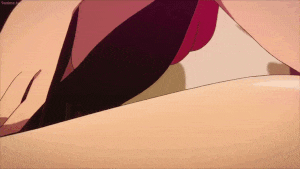 Sexuality being depicted in media as devious or devilish is directly responsible for making us always feel guilty about our pleasures, but also for making demons and villains unreasonably hot. There is also an inherent queerness to be explored in a story about young girls learning to process their reality by playing pretend. Aside from the obvious surface level stuff like Papika being Cocona's opposite - bringing out the best in her worst, in a manner of speaking - there are a lot of key moments between them that point to feelings rooted in love, whether romantic or otherwise. There's an entire episode dedicated to a Pure Illusion full of classic high school romance tropes, where Papika plays the part of various school sweethearts, both feminine and masculine in nature. Somewhere along the way, the adventure presents a Ship of Theseus sort of question about whether or not Cocona would still love Papika if she were to change, and become this or that type of person. Ultimately, Cocona ends up answering that it doesn't really matter to her whether Papika changes or not, but it DID matter that none of these variations she'd met in this world were actually her, and that the only thing she wanted was to find the real Papika. This, of course, ends up being the "answer" that helps her find the Amorphous shard for that world when Papika later shows up in a rocket ship to save her from a sinkhole of depression. It's a sly, subtle message, the type I wouldn't normally count as "explicit queerness", but the fact that it happens within an episode about romance tropes specifically kind of says it all. I mean, it also helps that a few episodes later, Papika and Cocona help each other escape from imprisonment through a blatant declaration of love for each other, but I digress.
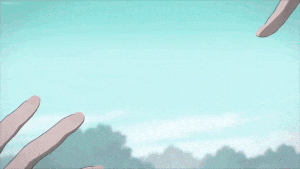 I'm just saying, if you regularly imagine you and your friend conquering your fears through the power of love, and then transform into wedding dress battle armor together, I think it's safe to say you see yourselves as more than "just friends". If the show has any major flaws to it, it's that from time to time (not particularly often) there are some awkwardly sexualized costumes and camera angles that are a bit off-putting and unnecessary. This is a show about school kids after all, and there's no part of the story for which this sort of thing is relevant, so there's not exactly a good reason for it to be the way that it is. It's a topic I'd like to delve deeper into - especially after I defended exploring sexuality in fictional shows about teenagers in my Gushing Over Magical Girls review - but THIS review is already enough of a rigmarole, so I won't do it here. In fairness, these shots are somewhat rare and brief, and don't detract much from the story beats that accompany them, to the point that I all but forgot they even existed before rewatching the show. I do however feel that it's worth mentioning as a forewarning to anyone interested in watching the show for themselves.
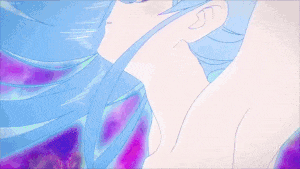 At the end of the day, bodies are just bodies, and it's up to you to deal with how you feel about them. Not to put too fine a point on it, Flip Flappers is undoubtedly still a top-shelf series for me. A visual feast for the eyes that takes you on a wild phantasmagoria of a roller coaster ride, it's easily one of the most overwhelmingly original shows of the past decade. It's fairy tales for girls who like weird shit (which, let's be honest, is most girls) with a touch of introspective Neverending Story whimsy and some lovely queer undertones to boot. From its high energy opening song to the playfully mysterious end credits theme, it's a trippy daydream adventure all the way through. Whether my interpretation of the story is accurate or not, I feel that using your imagination TO interpret and understand the reality you live in and the person you want to be is the show's major cornerstone upon which the rest of it is built. I know it won't be everyone's cup of tea, but if you're in the mood for something adventurous and decidedly different, make this one a priority. The show moves very quickly, and can be difficult to keep up with, but it's only 13 episodes in total, and VERY rewarding once you see all the pieces of its myriad puzzles come together. And despite a few weird moments of unnecessary lolification, I reiterate that Flip Flappers deserves its place in the hallowed halls of the all-time greats.
 Surreality is one of the greatest assets in all of animation, so I hold any cartoon that makes use of it near and dear to my heart. If you've already seen Flip Flappers and want to watch something along those same lines of escapism and imagination, one other oft-overlooked title I'd like to recommend for follow-up is Magical Shopping Arcade Abenobashi. Following a similar adventure-of-the-week format between each episode, both shows rely on taking their characters through a fever dream of genre-hopping escapades in service of a narrative about growing up. Like Flip Flappers, it relies heavily on the inherent charm of playing pretend, while also providing a mysterious overarching plot concerning the unforeseen circumstances of retreating to your own imagination. Some other shows you may also enjoy are the demonic daydream battlefields of Dream Eater Merry, or the wacked-out adventure antics of Train To The End of The World. If you're just in it for the pure escapism or the swapping between fantasy and reality (and you're allergic to isekai anime), try cartoons like ChalkZone, Twelve Forever, or even Captain N: The Game Master.
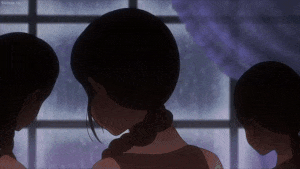 I revel in this nightmare, but I keep waking up too soon... On one final note, did you notice how I got through this entire review of a strikingly visual magical girl-esque anime without once comparing it to or even mentioning Madoka Magica? Not to downplay Madoka as a series, but I find people draw FAR too many comparisons to that anime, as if no show before or after it ever did the things it did. No matter what popular opinion suggests, Madoka is not the ultimate example of a dark or intellectual magical girl story, nor is any similarly complex, grim, or heady magical girl show a clone or rip-off of it. My personal challenge to you is to watch more magical girl (and magical girl adjacent!) shows, and to stop likening them to Madoka. Look into the roots of the genre and see for yourself how far back those dark and scary influences really go! You'll see that Madoka is not unique in what it explores, and that so-called "clones" of Madoka were also drawing inspiration from other sources that long preceded it as well. It's important to know your history, kids!
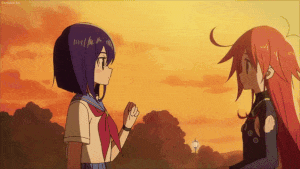 Yeah, this about sums up how it feels to watch any other show after watching Flip Flappers.
|
|